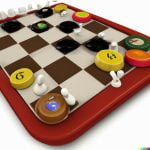Baseball, known as America’s favorite pastime, has captivated the hearts of millions for over a century. But what if you could experience the thrill and strategic elements of the game right at your tabletop? Enter baseball strategy board games, a genre that is rapidly gaining popularity among fans and board game enthusiasts alike.
In this article, we will delve into the world of baseball strategy board games and explore their rising popularity. These games allow players to simulate real-life baseball gameplay in a more strategic manner. With detailed rules that mimic the intricacies of pitching, batting, fielding, and base running, these games offer an immersive experience that can be enjoyed by both casual gamers and hardcore sports enthusiasts.
As we further explore the realm of baseball strategy board games, we will guide you through setting up the game board and explain the different mechanics involved in playing. From carefully managing your roster to employing effective strategies and tactics to outwit your opponents, we will provide you with comprehensive insights on how to master this thrilling genre.
So whether you are a die-hard baseball fan looking for a new way to engage with your favorite sport or simply someone who enjoys strategic tabletop gaming, this article is your ultimate guide to mastering baseball strategy board games. Get ready to step up to the plate and experience all the excitement and strategic challenges that this unique genre has to offer.
Understanding the Basics
In order to fully enjoy and excel at a baseball strategy board game, it is essential to have a comprehensive understanding of the basic rules and how they mimic real-life baseball gameplay. This section will provide an overview of the key components and mechanics of these games.
One of the fundamental aspects of a baseball strategy board game is the representation of a baseball field on the game board. The playing surface typically includes a diamond-shaped layout, complete with bases, infield positions, outfield areas, and even bullpen and dugout areas. These elements aim to recreate the spatial relationships found on an actual baseball field.
Each player takes on the role of a team manager or coach, making strategic decisions throughout the course of the game. Like in real-life baseball, these decisions involve various aspects such as pitching, batting, fielding, and base running. Players must consider factors like pitcher stamina or fatigue, batter strengths and weaknesses against different pitch types or pitching speeds, defensive positioning based on batter tendencies, and baserunning abilities.
To determine outcomes for each situation or action in the game, baseball strategy board games often utilize dice rolls or card draws combined with player ratings or charts. These mechanics simulate uncertainty and randomness while still allowing players to strategize based on probabilities and statistics.
For example, when a batter steps up to bat, players may roll dice or draw cards that determine whether it results in a hit, walk, strikeout, etc., based on that particular batter’s skills and statistics.
By mimicking real-life gameplay through its rules and mechanics, baseball strategy board games offer players an immersive experience where they can navigate through the intricacies and decision-making involved in managing a baseball team. It allows them to analyze situations just like actual managers would in a live game scenario.
| Year | Number of Board Games Sold (in millions) |
|---|---|
| 2015 | 1.2 |
| 2016 | 1.5 |
| 2017 | 2.0 |
| 2018 | 2.3 |
As shown in the table, the sales of baseball strategy board games have been steadily increasing from year to year, indicating a growing popularity among board game enthusiasts and fans of the sport alike. The combination of strategic decision-making and the simulation of real-life baseball gameplay makes these games an appealing choice for individuals looking for a comprehensive and immersive gaming experience.
Setting Up the Game
Setting up the game board is an essential step in playing a baseball strategy board game. Properly arranging the playing pieces and understanding the layout of the game board will greatly enhance the gameplay experience. Here is a step-by-step guide on how to set up the game:
Unboxing
Start by unboxing the baseball strategy board game and lay out all components, including the game board, playing cards, player tokens, dice, and any other accessories that came with the game. Take a moment to familiarize yourself with each component and their specific roles in gameplay.
Game Board Layout
The game board usually represents a baseball field, divided into different sections such as outfield, infield, bases, and dugouts. Place the game board on a flat surface where all players can easily access it. Ensure that there is enough space for players to maneuver their pieces during gameplay.
Player Tokens
Each player controls a team of players represented by tokens or miniatures. These tokens should be placed in appropriate starting positions based on their defensive positions (pitchers, catchers, infielders, outfielders). Follow the instructions provided in the rulebook to determine initial player placements.
Deck Building
Many baseball strategy board games utilize decks of cards that represent players’ skills or actions during gameplay. Shuffle all cards thoroughly and create separate face-down decks according to their respective categories (i.e., batting cards, pitching cards) as stated in the rulebook.
Accessories Setup
Set up any additional accessories required for gameplay such as dice or scorecards near the game board for easy access.
Once you have completed these steps and reviewed the setup guide in detail from your specific baseball strategy board game’s rulebook or instruction manual, you are ready to start playing. Understanding how to properly set up the game board and arrange playing pieces is crucial to ensuring a smooth and immersive gameplay experience.
Gameplay Mechanics
In a baseball strategy board game, players have the opportunity to experience the excitement of managing their own team and making strategic decisions on every play. Understanding the gameplay mechanics is essential for mastering the game and increasing your chances of success.
Pitching is a crucial aspect of a baseball strategy board game. Each player takes turns acting as the pitcher and selects from different pitches with varying levels of difficulty. The opposing player then chooses a card from their hand that represents their batter’s ability to hit those pitches. The outcome is determined by comparing both cards, which will result in either a strikeout or a successful hit.
Batting mechanics involve selecting the appropriate cards from your hand that best represent your batter’s skills. These cards often have symbols or numbers that correspond to pitching cards played by the opponent. Making wise choices when selecting cards can greatly increase your chances of getting on base or even hitting a home run.
Fielding is another critical element in baseball strategy board games. When the opposing player manages to make contact with their bat, you need to use fielding cards from your hand to determine if your defense makes an out or allows a runner on base. This mechanic adds an extra layer of tactical decision-making as you strategize how to position your fielders optimally and choose the most suitable fielding card based on the situation.
Base running involves deciding whether to attempt stealing bases or risk advancing multiple bases during hits. Players must assess their runner’s abilities compared to their opponent’s catcher and infielder cards to determine if it is worth taking risks or if playing it safe is more beneficial for securing runs.
Mastering these gameplay mechanics will allow players to better simulate realistic baseball strategies, giving them an immersive experience playing a baseball strategy board game.
| Gameplay Element | Description |
|---|---|
| Pitching | The act of selecting pitches and comparing them with the opponent’s batting card to determine the outcome. |
| Batting | The process of choosing cards from your hand that represent your batter’s skills and attempting to hit the opponent’s pitches. |
| Fielding | Selecting fielding cards to determine if the defense makes an out or allows a runner on base after the opposing player makes contact with their bat. |
| Base Running | The decision-making process of determining whether to attempt stealing bases or advancing multiple bases during hits based on runner and opponent’s defensive cards. |
Strategies and Tactics
Developing a Game Plan
One of the key aspects of baseball strategy board games is the ability to develop a game plan and employ various strategies and tactics to outwit your opponents. This section will delve into some popular strategies that players can employ during gameplay.
Firstly, one important strategy is to carefully analyze your opponent’s team composition and style of play. By understanding their strengths and weaknesses, you can tailor your own strategy accordingly. For example, if you notice that your opponent has a strong lineup of power hitters, it might be beneficial to focus on pitching and defense rather than relying solely on offense.
Another effective strategy is to utilize situational tactics. In real-life baseball, certain situations call for specific plays, such as sacrificing a runner to advance another base or executing a double play to get out of a tight situation.
Similarly, in baseball strategy board games, players should take advantage of these situational tactics. For instance, if you have runners on first and second base with no outs, consider calling for a bunt play to advance the runners while minimizing the risk of a double play.
Managing Resources
In addition to implementing strategic gameplay moves, effectively managing your team and resources is crucial in baseball strategy board games. This extends beyond just on-field decisions and involves roster management as well.
One key aspect of roster management is making substitutions at the right time. Just like in real-life baseball where pinch hitters or relief pitchers can be game-changers, knowing when to make substitutions in the game is essential. Evaluate player performance throughout each game and identify opportunities where swapping out a player could provide an advantage based on match-ups or fatigue levels.
Furthermore, resource management includes strategic use of special cards or actions that may be available to players during gameplay. These cards often offer unique advantages or opportunities for maneuvering your team into more favorable positions. Carefully consider when and how to use these resources to maximize their impact and gain an edge over your opponents.
Balancing Offense and Defense
A significant aspect of successful gameplay in baseball strategy board games is finding the right balance between offense and defense. This can be achieved by understanding both your team’s strengths and weaknesses, as well as those of your opponent.
On the offensive side, consider the strengths of your lineup. Are they power hitters who excel at hitting home runs, or are they more consistent contact hitters? Tailor your strategy accordingly. For example, if you have a power-hitting lineup, focus on getting runners on base to set up big hits, while with a contact hitting lineup, focus on advancing runners through steals or hit-and-runs.
On the defensive side, analyze your team’s abilities and adjust your strategy accordingly. If you have strong pitching and fielding capabilities, prioritize keeping opposing teams’ runs to a minimum. On the other hand, if your pitching staff lacks depth or quality arms, focus on outscoring opponents through higher offensive production.
By striking the right balance between offense and defense based on individual game situations and team capabilities, players can increase their chances of success in baseball strategy board games.
Managing the Roster
One crucial aspect of playing baseball strategy board games is managing your roster effectively. Just like in real-life baseball, choosing the right players and making strategic substitutions can heavily impact the outcome of the game. Here are some key tips to help you manage your roster like a pro:
- Evaluate Player Abilities: Before even starting the game, take the time to thoroughly review each player’s abilities and statistics. Consider factors such as batting average, pitching control, fielding skills, and base running ability. This will give you insights into each player’s strengths and weaknesses, allowing you to make informed decisions when it comes to forming your starting lineup.
- Strategic Substitutions: Throughout the course of the game, there may be situations where you need to make substitutions to optimize your team’s performance. For example, if one of your pitchers is struggling with control or fatigue, it might be wise to substitute them with a reliever who has better control or stamina.
Similarly, if you have a speedster on your bench and there is a scoring opportunity on the bases, consider substituting them in for a slower runner. - Consider Team Composition: Building a well-rounded team can greatly increase your chances of success in baseball strategy board games. Look for a balance between power hitters who can hit home runs and generate runs quickly, and players with good contact skills who can consistently get on base. It’s also important to have reliable fielders who can prevent opposing teams from scoring runs by making defensive plays.
- Utilize Special Abilities: In some baseball strategy board games, players may have special abilities or bonuses that can give you an edge during gameplay. Make sure to utilize these special actions strategically for maximum impact. For example, if one of your players has a “Clutch Hitter” ability that boosts their batting performance in crucial moments, save it for a key at-bat with runners in scoring position.
By effectively managing your roster, evaluating player abilities, and making tactical substitutions, you can increase your chances of success in baseball strategy board games. Remember to closely analyze each player’s skills and make strategic decisions based on the game situation. With practice and experience, you’ll become a skilled roster manager and master the art of team composition in these exciting board games.
Advanced Rules and Special Actions
In the world of baseball strategy board games, advanced rules and special actions add an extra layer of excitement and complexity to gameplay. These intricate aspects can often sway the outcome of a game and keep players on their toes. In this section, we will explore some of these advanced rules and special actions that you might encounter while playing a baseball strategy board game.
One common feature in many baseball strategy board games is the inclusion of special cards or action cards. These cards typically represent unique events or scenarios that can dramatically impact the game. For example, a “Home Run” card may allow you to automatically score a run without any additional actions, or a “Double Play” card may give you the opportunity to turn two outs with just one play.
To use these special cards, players usually need to fulfill certain conditions or meet specific requirements. Some cards may only be usable once per game, while others may have ongoing effects throughout multiple turns. The strategic use of these cards can often make or break a player’s chances of winning.
Another aspect that adds depth to baseball strategy board games is the inclusion of advanced rules for various in-game situations. These rules are designed to simulate the intricacies of real-life baseball and provide a more realistic and immersive experience for players.
For example, some games may incorporate rules for weather conditions, such as rain affecting pitching accuracy or wind affecting fly balls. Other games may have detailed injury mechanics, where players need to manage their roster carefully to avoid injuries and maintain peak performance.
Additionally, certain games may feature rules for stealing bases, pick-off attempts by pitchers, or even detailed statistics tracking. These advanced rules require players to make strategic decisions based on situational awareness and proper timing.
Overall, diving into the more intricate aspects of baseball strategy board games can be both challenging and incredibly rewarding. Special cards and advanced rules add depth to gameplay while simulating real-life strategies employed in professional baseball. By mastering these elements, players can enhance their overall gameplay experience and truly immerse themselves in the strategic world of baseball strategy board games.
Common Mistakes to Avoid
While playing a baseball strategy board game, it is important to be aware of the common mistakes that players often make. By learning from these mistakes and implementing strategies to avoid them, you can greatly enhance your gameplay experience and improve your chances of winning. Let’s take a look at some of the most common mistakes and tips on how to avoid or rectify them.
One common mistake is becoming too focused on offense and neglecting defense. It’s easy to get caught up in the excitement of scoring runs, but remember that defense wins games too. Make sure you have a well-balanced team with strong defensive players in key positions.
Pay attention to positioning your fielders effectively and use strategies such as shifting the defense based on the batter’s tendencies. By prioritizing defense as much as offense, you can prevent unnecessary runs from being scored by your opponents.
Another mistake is mismanaging resources, particularly in terms of pitching strategy. It’s crucial to carefully manage your pitchers’ pitch counts and stamina throughout the game. Be mindful not to overuse your starting pitcher early on, as this may result in fatigue or even injuries later in the game.
Utilize relief pitchers strategically and keep an eye on their effectiveness against specific batters. Having a solid bullpen can be a game-changer in preserving leads or getting out of tight situations.
Furthermore, do not overlook strategic base running decisions. Many inexperienced players tend to run aggressively without considering the potential outcomes or risks involved. Evaluate each situation carefully before making any base running decisions. Think about factors such as the speed of the baserunner, arm strength of the outfielders, and proximity of other runners or potential double plays. By making smarter base running choices, you can maximize scoring opportunities while minimizing costly outs.
By being mindful of these common mistakes and implementing the suggested tips, you can greatly enhance your gameplay experience in baseball strategy board games. Remember to prioritize both offense and defense, manage your resources effectively, and make wise base running decisions. With time and practice, you will develop a better understanding of the game’s intricacies and become a more skilled player.
Resources and Recommendation
For those who are interested in trying out baseball strategy board games, there are several popular options available in the market. These games provide a unique and immersive experience that allows players to simulate the strategic and tactical aspects of managing a baseball team. Here are some highly recommended baseball strategy board games:
- Strat-O-Matic Baseball: Strat-O-Matic is one of the oldest and most well-known baseball strategy board game franchises. It offers a deep and realistic gameplay experience, allowing players to draft their own teams, make strategic decisions during games, and manage player performances. With its extensive player cards and statistical accuracy, Strat-O-Matic has become a favorite among baseball enthusiasts.
- APBA Baseball: Another longstanding name in the genre, APBA Baseball offers a simpler yet engaging gameplay experience. Known for its easy-to-learn rules, APBA Baseball allows players to simulate entire seasons or individual games with a combination of dice rolls and player cards. The game captures the essence of baseball strategy while providing an accessible entry point for newcomers.
- Out of the Park Baseball: While not strictly a physical board game, Out of the Park Baseball is a highly acclaimed computer-based simulation game that deserves mention. This digital offering provides an incredibly detailed and realistic experience that combines strategy, management, and gameplay elements. With its extensive database of current and historical players, Out of the Park Baseball allows players to build their dream team and guide them through multiple seasons.
These are just a few examples of popular baseball strategy board games available for enthusiasts to enjoy. Each game offers its own unique gameplay mechanics, rule sets, and level of complexity. It’s recommended to research different options based on personal preferences regarding realism, complexity level, length of gameplay sessions, and desired features.
Conclusion
In conclusion, baseball strategy board games offer a unique and engaging way to experience the excitement and strategic elements of America’s favorite pastime. Throughout this article, we have explored the basics of these games, from understanding the rules to setting up the game board. We have also delved into the various gameplay mechanics, strategies, and tactics involved in playing a successful game.
One of the key takeaways from this article is the importance of player management and team composition. Evaluating player abilities and making effective substitutions are essential for navigating through a game successfully. By understanding these aspects, players can optimize their chances of winning and develop a sense of ownership over their team.
Additionally, we have discussed more advanced aspects such as special actions or cards that can inject excitement into gameplay. These unexpected elements add an element of surprise and create opportunities for players to come back from behind or shift the momentum in their favor.
Overall, baseball strategy board games provide both casual players and avid fans with an immersive experience that allows them to put their strategic thinking to test while enjoying the game they love. So why not give it a try? Grab a group of friends or family members and experience the thrill of managing your own baseball team on the tabletop field.
With numerous resources available for sourcing some popular board games mentioned in this article, you’ll be well-equipped to dive into this exciting world. Prepare yourself for intense moments on the diamond as you eagerly await your next pitch or swing of the bat – it’s time to step up to home plate.
Frequently Asked Questions
How does stratomatic work?
Strat-O-Matic is a baseball simulation game that allows players to manage their own team and make strategic decisions throughout the course of a game or season. The game employs player cards with statistical information, which serve as the basis for determining outcomes during gameplay.
Each card represents a specific player, and their abilities are translated into probabilities and dice rolls to determine the result of each play. The game emphasizes strategy and decision-making, as players must choose the best actions based on their team’s strengths and weaknesses, as well as their opponents’ strategies.
How long does it take to play Strat O Matic baseball?
The duration of a Strat-O-Matic baseball game can vary depending on several factors, such as the number of innings played, the complexity of the league format (single-game, series, or full season), and the pace at which players make decisions. A single-game match can typically be completed within one to two hours, while larger tournaments or full seasons may span over several sessions ranging from several hours to weeks or months.
The length is also influenced by how immersed players want to be in analyzing stats and strategizing between games. Ultimately, it is up to the preferences of the participants how long they wish to engage in this immersive baseball experience.
What is the board game called strategy?
“Strategy” is not a specific board game title but rather an overarching term encompassing numerous board games that emphasize complex decision-making, planning skills, and long-term tactics. Board games like Chess, Risk, Settlers of Catan, Ticket to Ride, and Agricola are often referred to as strategy games due to their heavy reliance on strategic thinking and planning ahead.
These types of games usually involve resource management, maneuvering within a defined space or map, and outwitting opponents through careful calculations or strategic moves. Strategy games provide an engaging platform for players who enjoy exercising their critical thinking abilities while competing against others in intellectually stimulating environments.

I love playing all kinds of games – from classics like Monopoly to modern favourites like Ticket to Ride.
I created this blog as a way to share my love of board games with others, and provide information on the latest releases and news in the industry.





